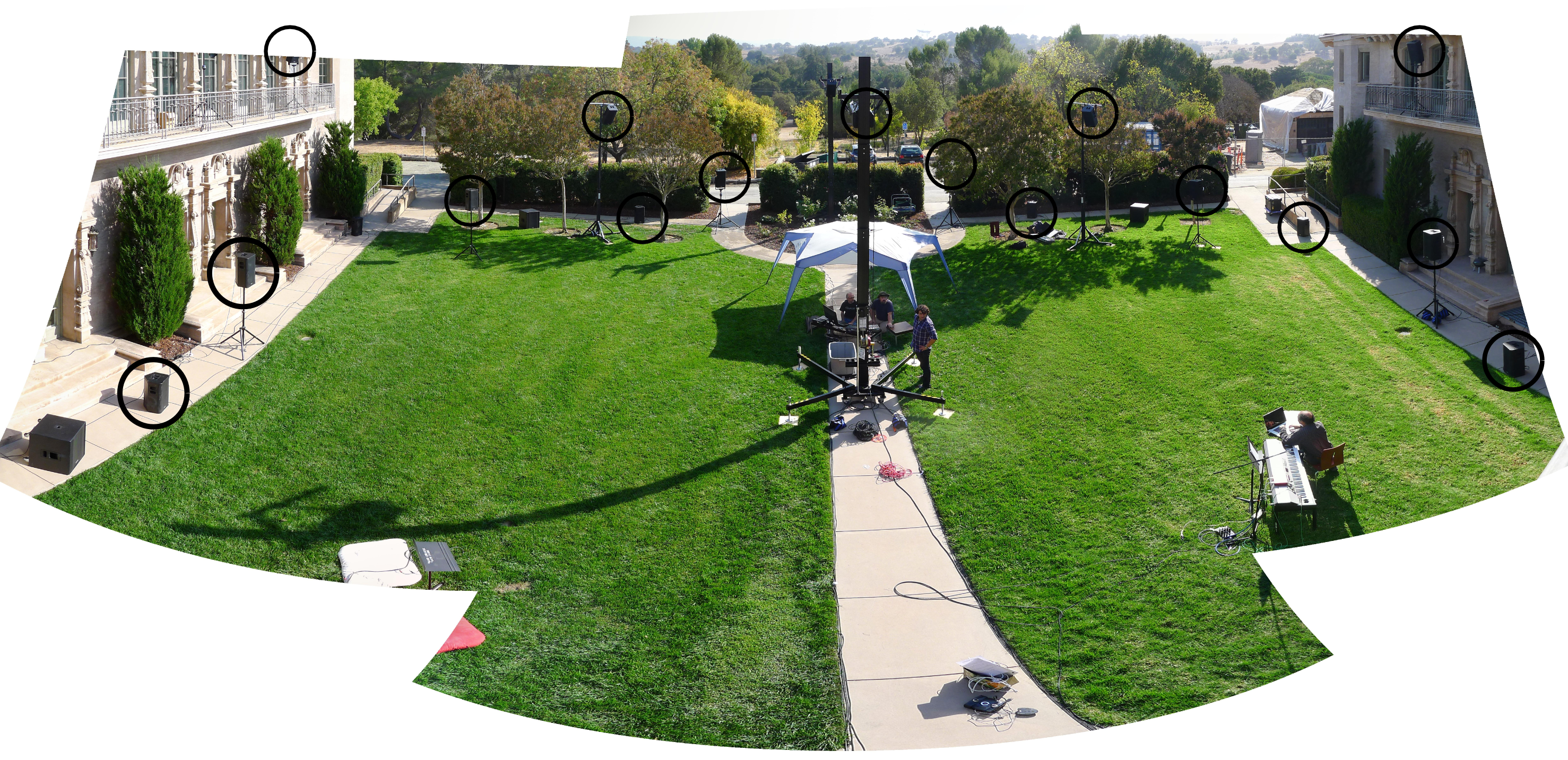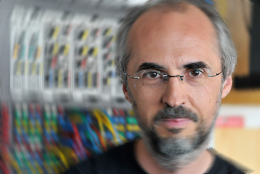CONCERTS
I have been doing multichannel concert sound and curating special concerts for a few years now (read this paper for some details on the underlying technology being used for sound diffusion). Here is a list of the latest events I have participated in:
Sound/Curator: More Bing for your Buck: CCRMA in the Bing Studio, Stanford, Bing Studio, May 20/21 2015
Another deployment of the Stanford GRAIL in the Bing Studio, again in a 3D 25.7 configuration. The placement of the 8 speaker ring at mid-height was changed to better span a wider audience (in the previous concert the edges of the seating area ended up being almost "behind" the 8 speaker ring).
The first concert was dedicated to student pieces form the Music 222 "Sound in Space" course I teach every two years, the second featured pieces by invited composers Ake Parmerud and Juan Pampin (together with the world premiere of one of my pieces).
Sound: Bruno Ruviaro: Cinema for the Ears, Stanford, Braun Rehearsal Hall, May 8 2015
Bruno Ruviaro presented his "Cinema for the Ears" piece in the Braun Rehearsal Hall using our 25.6 3D deployment of the Stanford GRAIL.
Sound/Curator: Hans Tutschku: Electroacoustic Works, Stanford, Braun Rehearsal Hall, April 10 2015
This is the first time we deployed our system in the Braun Rehearsal Hall. The configuration was again a 25.6 3D dome. This included a top center speaker but limited the number of subwoofers to 6 as it was easier to mount 6 speaker/subwoofer pairs (of the 12 floor speakers) in the limited floor space available. The 8 speakers at mid-heigth were mounted on the existing ledges thanks to hardware assembled by John Granzow. The 5 speakers at the top were rigged and mounted by Kevin Sweetner from the Music Department. BRH proved to be a very good venue and the system was up and running for almost the entire duration of the Spring Quarter and was used to teach Music 222 "Sound in Space" in several occasions.
The Stanford GRAIL is born
Thanks to Alison Rush, one of my students in the "Sound in Space" Music 222 course, the speaker array finally has a name and a matching cool acronym. It is the Stanford (HOLI) GRAIL, or (HOLIstic) Giant Radial Array for Immersive Listening. Chris Chafe independently discovered that the acronym also means "GRAIL Renders Ambisonics In Linux" which is also true. The GRAIL has hidden meanings.
Sound/Curator: A Supersonic Bing Thing: CCRMA in the Bing Studio, Stanford, Bing Studio, March 13/14 2015
For these events we deployed our system in a 25.7 3D configuration. I added a top center speaker which gives us better spatial resolution in Ambisonics decoding of elevated sounds, regretfully that limits the number of subwoofers to 7 as I have only (at this point) 32 discrete output channels (25 + 7 = 32). This restriction will be lifted as soon as I have the new AVB boxes up and running under Linux.
Special invited guest composed, Joe Anderson from DXARTS.
Curator: 40, 50, 80 - CCRMA en Montevideo, Montevideo, Uruguay, Nov 11 2014
A multichannel concert (8 channel full surround) in the "Sala de Conferencias" of the Solís Theater in Montevideo, Uruguay. The concert setup and calibration session was also part of the Herramientas de Software Libre para la Espacializacón de Sonido (Free Software Tools for Sound Spatialization) workshop.
Sound: Triple CCRMAlite: 40, 50, 80, Bing Concert Hall, Stanford, October 26 2014
For this concert we deployed our sound system in a 2D 16.8 configuration. To try to minimize the latency for "Voices" (John Chowning's piece for soprano and electronic sounds) we ran the system at 64x2 frames of latency, the shortest ever. All speakers were digitally corrected with DRC. Sound diffusion done together with Elliot Kermit-Canfield.
Transitions 2014, CCRMA, Stanford, October 2, 2014
Our two evening Summer Outdoor Concerts happened again in our backyard. For this occassion we used a simple deployment of our 24.8 diffusion system. 16 speakers were arranged in a ring at ear level for very good horizontal rendering, and an additional 8 were installed in the balconies that surround the front and sides of the listening space. It was not a full 3D deployment, but at least for Ambisonics playback I used a decoder designed with ADT that used additional "virtual speakers" over and behind the audience. Those "speakers" were simulated by panning over the existing balcony and ground speakers.
Sound: CCRMA Winter Concert 2014, Bing Studio, Stanford, March 14, 2014
This was a full deployment of our 24.6 diffusion system in the Bing Studio. Speakers were arranged in 3 rings, 12 at ear level, 8 at rigged mid level and 4 at the highest level.
The same speaker system was used the following day for the CCRMA Teleconcert. (PDF)
Sound: CCRMA Fall Concert 2013, Bing Concert Hall, Stanford, December 4 2013
This time we avoided the major cost of rigging speakers and used a plain 2D setup with a main ring of 16 speakers surrounding the audience. Some of the pieces were diffused using 5th order Ambisonics.
Sound: Transitions 2013, CCRMA Backyard, Stanford, October 10, 2014
Sound: CCRMA Spring Concert 2013, Bing Studio, Stanford, May 28 2013
For this series of events we deployed the full 24.6 speaker array arranged in three rings of 12, 8 and 4. We also brought the small 32 speaker WFS array from the Listening Room as it was used by one of the students in her piece.
The same speaker deployment was used for the Stanford Dust concerts by Robert Henke (on May 23rd and 24th 2013).
Sound: Visitations: The War Reporter and Theotokia, Bing Concert Hall, Stanford, April 12/13 2013
Curator/Sound: CCRMA at Bing: Sonic Boom!, Bing Concert Hall, February 16 2013
This was the first full CCRMA concert in the newly inaugurated Bing Concert Hall at Stanford. We deployed for the first time our new 24.6 speaker array in a full 3D configuration (12 + 8 + 4).
Side view of the speaker array:

Top view of the speaker array:

Curated program
The curated program featured an introduction in memory of Max Mathews of "Bicycle built for two" as arranged by him, and played in mono from a boombox on stage. This was followed by a first audition in the US of "Mortuos Plango, Vivos Voco" by Jonathan Harvey in its 3D 8 channel version. "Tomato Music", by Chris Chafe, was also diffused directly to all speakers. "Velvet Skin, Heart of Steel" a 3D Ambisonics piece (by myself) uses sounds recorded from the Bing construction project, it is Bing inside Bing. "Engine", by Michael Berger used very successfully 3D realtime spatialization with the composer in the driver's seat of the diffusion (it is a piece that uses engine sounds). "Prologe from Theotokia" by Jonathan Berger gave us a preview of the beautiful electronic sounds of his upcoming chamber operas. "Klaviersammlung", for 16 speakers, by Hans Tutshcku was finally followed by a 3D rendering of "Kitchen \<-\> Miniature(s)" that used all 24 speakers.
The same speaker array was used in the CCRMA at Bing: Sonic Bing! concert the previous day (February 15th 2013, concert program, PDF).
Sound: From Constantinople to California, Bing Concert Hall, February 1st 2013
A Stanford Live event in the first season of the Bing Concert Hall, "From Constantinople to California" presented the Cappella Romana group in a dual context. During the first half of the concert they performed in the Bing Concert Hall. After the intermission we switched on our diffusion system and the singers and audience were transported in space and time to the acoustics of Hagia Sophia in Istambul, Turkey.

Snapshot from the Stanford Live web site
This was the culmination of a long project by the Icons of Sound project led by Jonathan Abel. Using carefully reconstructed decorrelated impulse responses, the acoustics of Hagia Sophia were recreated inside the Bing Concert Hall. All 15 singers used wireless microphones to feed signals to one of our Linux workstations, which was running 48 16 second convolutions that, when spatialized around the audience using Ambisonics and a dome of 24 speakers, recreated the feeling of being inside the main dome of Hagia Sophia. Read my LAC2013 paper ("Byzantium in Bing: Live Virtual Acoustics Employing Free Software"), a summary of technical details that made this concert possible.
Curator/Sound: Transitions 2012: Night 1, Soundscapes under the Stars, CCRMA Backyard, Stanford, September 27 2012
Our first full 3D sound event in our backyard. Another test for the upcoming first season at the Bing Concert Hall. This time with 24 main speakers and six subwoofers. We rented 4 speaker towers, installed one in the center of our backyard and three more in the back. With this we managed to get full 3D coverage for a full surround experience.

Curated program
Bill Schottstaedt had just retired, so this concert was in part for him. I re-rendered three of his pieces replacing the original locsig sound location ugen (originally used to render these pieces in quad) with a modified version that created full 3rd order Ambisonics renderings instead. The result were stunning new versions of movements 3 and 5 of "Colony" as well as "Dinosaur Music", which closed the concert. I also played "Etude for Nando" by Jonathan Berger, a re-rendering of "Knock Knock, anybody there?", a piece I originally wrote for quad in 1994, "Inside Out", a full 3D piece by Chris Chafe, "Trisagion", the first live test of simulating the acoustics of Hagia Sophia and "Grooves" by Ake Parmerud, a 43 channel piece made of surface noises of vinyl records. A very successful program for our first full 3D speaker deployment.
Curator/Sound: Transitions 2011 Night 1: Soundscapes under the Stars, CCRMA Backyard, Stanford, September 28th 2011
16 speakers, 4 subwoofers, two rings of 8 speakers with elevation. We used the balconies at The Knoll and three (not quite) tall speaker stands in the back to create the first ever 3D surround event at CCRMA.
Curated program
Fernando Lopez-Lezcano

Composer, performer, lecturer and computer systems administrator at CCRMA, Stanford University
Quick Links
Planet CCRMA(C)1993-2023 Fernando Lopez-Lezcano. All Rights Reserved.